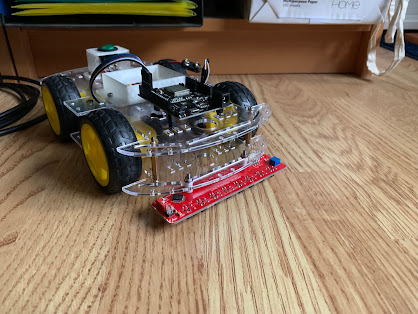Here's our first experimental line follower mount, designed to be able to handle the bump in the Lava Palaver challenge and still keep following the line.
It's been drawn up in TinkerCAD and anyone who wants to play can copy it from here https://www.tinkercad.com/things/lRdxtf15kXL .
It's only an experiment to mount the line follower sensors on a hinged board supported at the front by two ball bearing castors which will raise the sensor in line with the robot travelling over the bump. A spring is fitted across the hinge to provide the means to keep the sensor in the right position as it hits the bumps and rides over the other side. A bracket is also fitted to support a microswitch fitting to detect when the robot is approaching the bump and also when it is just leaving. It's not shown in the picture above but is in the photographs. following.
This first picture shows the problem we need to get around, here the sensor is mounted on a low-cost chassis for testing. The sensor is very low and ahead of the front wheels meaning that when the robot encounters the bump in Lava Palaver it will collide with the bump and possibly damage the sensor.
A hinged sensor support has been created for testing, the extra slots and holes are for more easily changing the layout without making a new support. Here it's mounted on the low cost chassis for testing.
This picture shows the centrally located spring to provide downforce to the sensor mount so that it will remain in contact with the course as the robot negotiates the bump.
This last photo shows the microswitch which will be activated when the sensor mount first encounters the bump so informing the robot that it may need to slow down to safely negotiate the obstacle. It also shows the damage to one of the ball bearing castors which would be unlikely to survive the Lava Palaver course in competition so realistically will be replaced with a rolling castor.
The purpose of this experiment is to investigate the viability of using this method of navigation and also provides both detection of the bump as well as steering. It will probably be necessary to mock up a 'speed bump' to tell if this is needed or not, or whether the robot can use a line following sensor mounted on the robot chassis itself with perhaps accelerometers determining if the robot is travelling over the bump. The microswitch and lever may still be retained as it provides simple and useful advanced indication of the bump. There'll be an update later as to how we get on.







No comments:
Post a Comment